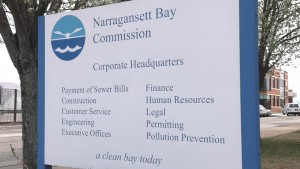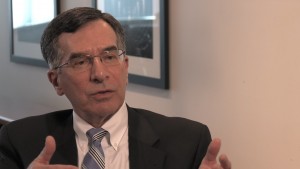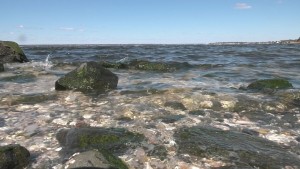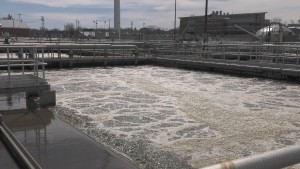 The science tells us that Narragansett Bay has not been this clean in 150 years. The days of floating debris and sometimes raw sewage after heavy rainstorms are squarely in the rearview mirror, largely because of a massive combined sewer overflow project that went online eight years ago. Often called The Biggest Project You’ll Never See, it is an underground holding tank of sorts that allows overflow to be contained, then fully treated, after a heavy rainfall.
The science tells us that Narragansett Bay has not been this clean in 150 years. The days of floating debris and sometimes raw sewage after heavy rainstorms are squarely in the rearview mirror, largely because of a massive combined sewer overflow project that went online eight years ago. Often called The Biggest Project You’ll Never See, it is an underground holding tank of sorts that allows overflow to be contained, then fully treated, after a heavy rainfall.
“We hear anecdotally from the shellfishermen, from the boaters, that they’ve never seen the Bay this clean in their lifetime,’’ said Ray Marshall, the executive director of the Narragansett Bay Commission, which handles the sewage for a third of the entire state. That includes the communities in metropolitan Providence and the Blackstone Valley — serving a total of 360,000 people.
 But Marshall has also heard it from a scientist at URI, who is studying the water quality of Narragansett Bay. We first reported six years ago on Phase 1 of the CSO project, mandated by the federal Clean Water Act to achieve better water quality in the Providence River and Narragansett Bay.
But Marshall has also heard it from a scientist at URI, who is studying the water quality of Narragansett Bay. We first reported six years ago on Phase 1 of the CSO project, mandated by the federal Clean Water Act to achieve better water quality in the Providence River and Narragansett Bay.
That first phase carried a $375 million price tag. Phase 2 was completed at an additional cost of $213 million — a hefty price tag born solely by the 80,000 customers of the Bay Commission. So while customers don’t see where their sewage goes after it leaves their homes or businesses, they do get a monthly reminder of what it costs to treat. The water improvement projects translate into rates that have more than tripled over the past 15 years; from $137 a year in 2001 to $477 a year in 2016 for an average homeowner.
 “The improvements have been dramatic, and there’s still more to do,” Marshall said. “There are other sources of pollution, other than combined sewer overflows and treatment plants, such as storm water. All of these things take time and they cost money.”
“The improvements have been dramatic, and there’s still more to do,” Marshall said. “There are other sources of pollution, other than combined sewer overflows and treatment plants, such as storm water. All of these things take time and they cost money.”
On paper, the first two phases were supposed to take care of 60% of the pollution, but many feel it’s done much more than that. A planned Phase 3 would take care of the remaining 40% and will be the costliest segment — with an original estimate of more than $800 million. The commission has been able to make adjustments to reduce the cost to $760 million, but it still has some asking: How clean is clean enough?
The commission has been negotiating with the Rhode Island Department of Environmental Management, and by extension the federal Environment Protection Agency, to push back and spread out the construction timetable for Phase 3, which runs up the eastern side of the Seekonk River, into Pawtucket and Central Falls. That means rates should remain stable for at least the next several years.
 “So, instead of completing Phase 3 in seven years, which would be approximately 2025, we asked for 13 additional years out to 2038,” Marshall said. “That’s what we submitted to DEM. The thought is we’ll stretch the cost out over a greater period of time.”
“So, instead of completing Phase 3 in seven years, which would be approximately 2025, we asked for 13 additional years out to 2038,” Marshall said. “That’s what we submitted to DEM. The thought is we’ll stretch the cost out over a greater period of time.”
Another question is how a new administration in Washington, one that has been critical of the EPA, will affect projects and standards going forward.
Jim Hummel: Has there been any talk about a relaxing or a rolling back of clean water standards that would trickle down to you in terms of Phase 3?
Ray Marshall: That’s unclear at this time. I know that the Trump Administration has basically said for every new regulation that a governmental agency wants to impose, they have to roll back two. So I don’t know how within the EPA umbrella all of that will play out.
JH: It’s never good enough under the Clean Water Act until you reach 100%. Is that what I heard?
RM: That’s correct.
JH: And so that could be an awful lot of money for that last 5 or 10%.
RM: It could be.
JH: It’s the law of diminishing returns isn’t it?
RM: Absolutely, it is. We’re probably three years away from any major construction, so hopefully in that period of time the skies will clear and we’ll all understand what it is we’re supposed to do and then we can move forward — or not — depending on how things tumble into place. But I can’t imagine that we won’t have to do some form of Phase 3.
The Hummel Report is a 501 3C non-profit organization that relies, in part, on your donations. If you have a story idea or want make a donation, go to HummelReport.org, where you can also see the video version of this story. You can mail Jim directly at Jim@HummelReport.org.
More Posts by The Author:
The Hummel Report: A Quarterly Update
Hummel Report: New Rotary at CCRI
Rhode Island Spotlight: Westerly Library
The Hummel Report: Do We Need an Inspector General?
The Hummel Report: Age Is Just a Number … ‘Til it Isn’t



